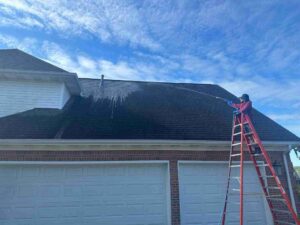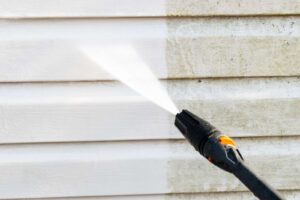How to Soft Wash a Roof
If your roof is showing signs of wear and tear, a soft wash cleaning can rejuvenate it without the risk of damage often by high-pressure systems. In this blog post, we’ll guide you through exactly how to soft wash a roof, ensuring a thorough and safe result.
What is Soft Wash Roof Cleaning?
Soft wash roof cleaning is a method that utilizes low-pressure water spraying to effectively clean roofs without causing damage. Unlike high-pressure washing, which can harm shingles, soft washing combines water with bleach, sodium hypochlorite, or other cleaning solutions. This mixture gently removes dirt, moss, and algae from the roof’s surface without causing harm to nearby plants.
To perform soft wash roof cleaning, specialized equipment such as a pressure washer set to a very low setting or low-pressure nozzles are used to apply the cleaners safely across the roof surface. This ensures thorough cleaning while safeguarding the integrity of the roof.
Overall, soft wash systems are gentle and highly effective in maintaining the appearance and prolonging the lifespan of your roof.
Why Soft Wash Your Roof
Soft washing your roof helps remove algae, mold, and other build-ups that can damage the roof over time. This process also avoids the potential damage that high-pressure washing can cause to delicate asphalt shingles.
Can I soft wash with a pressure washer?
You can soft wash with a pressure washer by adjusting it to a low-pressure setting, typically below 1000 PSI. This method is safe for cleaning roofs as it prevents damage caused by high pressure. When using a power washer for soft washing, attaching the appropriate nozzle, such as a wide-angle nozzle or a nozzle specifically designed for soft washing, is crucial.
It’s also essential to use appropriate chemicals together with water to effectively remove dirt, algae, moss, and other build-ups without harming your roof’s surface. Commonly used chemicals include sodium hydroxide or hydrogen peroxide, which help break down and remove organic matter.
How To Soft Wash A Roof
To soft wash a roof, you must prepare the area and apply cleaning chemicals. Then, rinse thoroughly for a safe and effective result. Here’s the step-by-step guide:
Pre-treatment and preparation
Soft wash roof cleaning starts with good preparation. This step is key to protecting you, your home, and your yard during roof cleaning.
- Check the weather forecast and pick a dry day with mild temperatures.
- Wear safety gear like gloves, goggles, and non-slip shoes to protect yourself.
- Clear patio furniture, cars, and toys so they are not damaged. Wet your plants and grass around the house and cover delicate plants with tarps or plastic sheets that would be at risk of direct contact with the chemicals.
- Mix the cleaning solution according to the instructions. Common ingredients include sodium hypochlorite or hydrogen peroxide mixed with water.
- Fill a backpack sprayer with the solution. A backpack sprayer is easier to handle on a ladder than other types.
Application of chemicals
Applying cleaning agents is a key step in soft washing your roof. It removes dirt, mold, and stains without harsh pressure. Here’s how to do it right:
- Choose the right solution. Look for products made for roof cleaning that contain sodium hypochlorite or hydrogen peroxide. Their strong oxidizing properties are good for breaking down and removing organic matter and stains.
- Use a garden sprayer for application. Fill it with your cleaning mixture, then gently spray it evenly onto the roof surface. You can also use a pressure washer with a chemical application attachment. This can help ensure even coverage and can be especially useful for larger roofs or for reaching high areas more easily.
- Let the solution sit on the roof, but don’t let it dry out completely. This allows time for the chemicals to work into the soil and stains.
Rinsing
- Rinse thoroughly with low pressure after waiting the recommended time, which can be around 15 – 30 minutes depending on the product’s directions.
- Check the roof for any remaining chemical residue or stubborn stains. If necessary, reapply the cleaning solution to tough spots and rinse again.
- Ensure that gutters and downspouts are clear of debris to allow proper drainage of the rinse water.
What is the formula for soft wash on a roof?
The standard formula to eliminate algae and moss usually consists of an equal mix of laundry-strength liquid chlorine bleach and water. This solution is both effective and safe for breaking down and eliminating organic growths on the roof’s surface. It’s essential to follow the manufacturer’s instructions and safety guidelines when using bleach,
Additionally, incorporating a surfactant or detergent into the mixture can enhance its cleaning power by helping it adhere to the roof and penetrate stubborn stains more effectively. Conducting a spot test on a small, inconspicuous area of the roof is recommended before applying the solution to ensure compatibility and avoid potential damage.
Contacting Professional Roof Cleaners
Choosing professional roof cleaning services like us, ensures thorough and safe soft wash treatments. Experts use specialized equipment to remove dirt, algae, and other contaminants without damaging the roof or surrounding property, often providing guarantees.
For basic maintenance, DIY soft washing can be manageable with proper safety gear. However, for extensive cleaning, steep angles, delicate materials, or significant buildup, professional services are the wiser choice for optimal results and minimized risks.
Conclusion
Use soft wash techniques with low pressure and specialized chemicals to achieve a safe and effective roof cleaning. This method is essential for removing bacteria and fungal growth without causing damage.
Consider hiring professional cleaners who utilize drones for precise and efficient results. soft washing ensures safety and preserves the integrity of your roof structure. Embracing this approach will guarantee a clean roof without compromising its quality or safety for workers.


